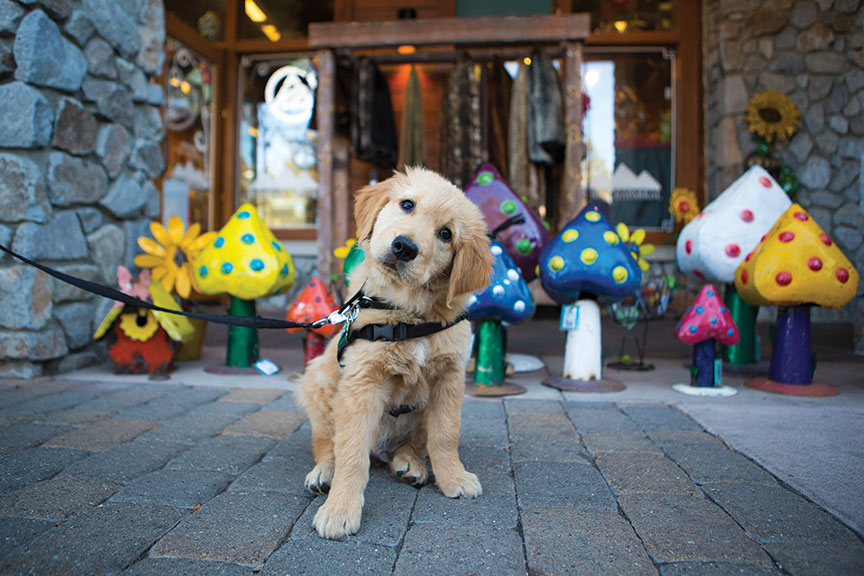
14 Jul Guiding Lights
Locally raised dogs open the world to the blind
In the world of dogs there are many occupations, all exceptional in their own right. Some detect cancer; others, drugs. Some apprehend criminals; some serve overseas with similarly brave humans. Some retrieve game proudly, happy to be of service; others help children read with confidence or comfort the sick. Some rescue humans from earthquake debris or avalanches. Even the sweetest family pet does his job with pride, vacuuming up dropped food better than any cleaning tool on the market and dutifully warming the foot of the bed at night.
Guide dogs for the blind, though—these truly extraordinary dogs—rescue their humans from a world of limitation, isolation and darkness. They bring light into spaces where it is needed most.
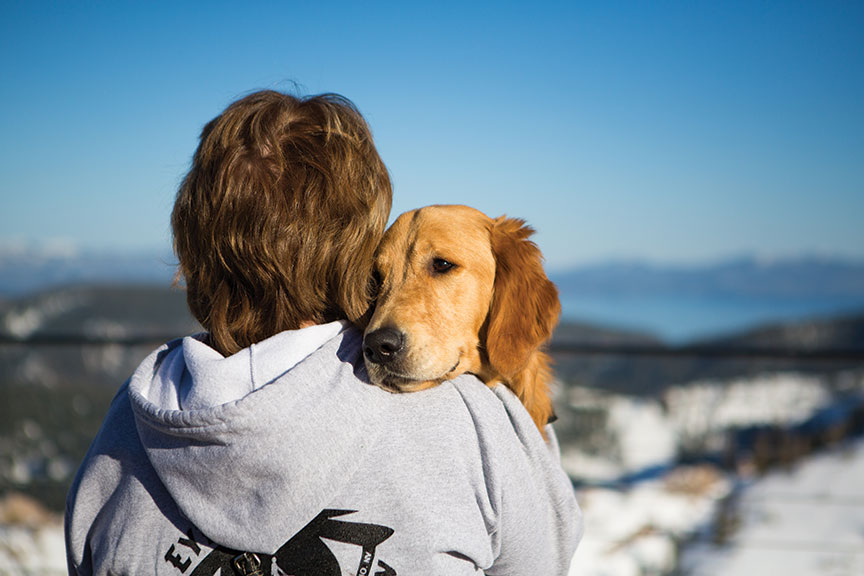
Vicki Moss with “Pele”
Puppy Prep
Founded in 1942, Guide Dogs for the Blind is an industry-leading guide dog school serving the visually impaired. Its mission is to empower lives by creating exceptional partnerships between people, dogs and communities, and the organization has existed in the Reno/Tahoe area as far back as the 1950s, says guide dog raiser and Carson City club leader Warren Wish.
Wish, a retired middle school counselor, became involved with the program in the early 1980s when a fellow teacher suggested his skills counseling young people would make him an excellent puppy raiser. The suggestion proved right: Over the past three decades, Wish and his wife, Claudia, have personally raised 28 guide dog puppies, helped raise many others and served as group leaders for 25 years.
It all begins with breeding. Guide Dogs carefully selects dogs, often golden and Labrador retrievers, that display high intelligence, calm temperaments and good health. These dogs want to work with people, are confident and have the ability to make decisions and handle a very complicated world. In short, the very best dogs from every generation become the breeders of the future generation.
As part of an international association of guide dog schools, Guide Dogs sends pups as far away as New Zealand, England, Holland and Australia, exchanging puppies to keep the breeding stock diverse and healthy.
Each litter is born at Guide Dogs’ main San Rafael, California, campus (there’s a secondary campus outside of Portland, Oregon, as well). Before their eyes open, puppies are handled, touched and interact with people. Volunteers and 24-hour staff work with the expecting mothers, the breeding mothers and the newborn puppies. At six weeks old, the puppies begin learning about stairs, walking on a leash, and hearing their first traffic sounds. At eight weeks old, they are placed with families all over the Western states, ranging as far east as Colorado and Texas.
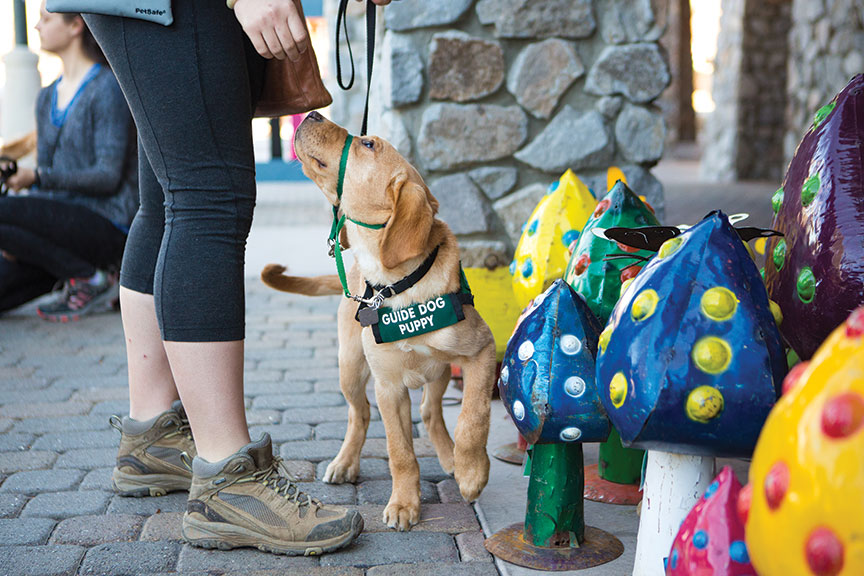
“Kenneth” checks out the strange objects in front of a shop in Heavenly Village. Guide dog puppies need to see
and smell everything they can in order to be prepared for life with a blind person
Anyone from middle school students to retirees can be raisers, and often two people or families co-raise a puppy or two. Kelsey Mammen, 22, and Emily Cook, 21, are best friends, roommates in Reno and University of Nevada, Reno (UNR) graduates. Between them, they have raised 12 puppies since joining the Carson City club (at Wish’s encouragement as their former school counselor) nearly ten years ago. At first, it seemed like just a great way to convince their parents to get a dog. The pair bonded through Guide Dogs because their first two puppies were siblings, and ever since they have co-raised two puppies at a time, switching the puppies back and forth on a weekly or biweekly basis. Switching helps the puppies not get so attached to one human and vice versa, they say, and maintains accountability in training.
Wish often helps newcomers by co-raising with them. The assistance of an experienced raiser creates a safety net for a first-timer. “It can be overwhelming, raising a guide dog puppy. It’s a 24/7 experience,” Wish says.
Until the pups are 16 to 18 months of age, the raisers train the puppies in basic obedience and good manners, using positive reinforcement, lots of treats and help from their local Guide Dogs club leaders and club mates. (The dogs even learn to relieve on command, on any kind of surface at any time.) With weekly meetings and regular outings, the main goal is to ensure the dogs are properly socialized and have had a wide variety of experiences.
Raisers take their dogs everywhere: school, grocery shopping, trips and plane flights if possible. It socializes the dog, as well as the people. Mammen and Cook, for example, were shy middle schoolers, but years of having a dog constantly by their side, an instant icebreaker, helped them come out of their shells. “You can’t even go shopping without being noticed, without people stopping you, without people asking you about your dog,” says Wish.
Wish’s club meets weekly and alternates between outings in the community and training sessions inside a community space. They encourage raisers to bring along family dogs, which socializes guide dog puppies and helps them learn to ignore distractions when they’re working.
The clubs take their dogs to fire stations, movies, restaurants, shopping malls, schools, bowling alleys, fitness centers, and city buses to help expose pups to anything they might encounter once they’re out in the world with their blind partner.
“If a fire engine goes by, the guide dog puppy has had an experience with a fire engine [when we visited the fire house] and so they’re not going to be afraid. They’ve been there, done that,” says Wish. “Literally, we try to duplicate all the experiences of an active life because I know that people out there who have guide dogs want that sense of independence. They want the ability to live a normal life.”
At the moment, the Reno and Carson clubs are raising about 20 puppies between them. Pups are placed all over the United States and Canada, even bustling cities like Manhattan, Miami, Los Angeles and Seattle. “We jokingly say to people, walking down Carson Street in our community prepares the dogs to go anywhere in the world,” says Wish.
Opening Worlds
Many of the visually impaired people Guide Dogs helps are ordinary people who go to work every day and have families, and their guide dog is a part of that family, says Wish. Others require more from their dogs, and the dogs happily oblige.
One blind employee of Guide Dogs, who has a guide dog of her own, has won numerous gold medals at the Paralympics as a rower on a crew team. Another person is a professional hiker who has hiked the Tahoe Rim Trail, the Appalachian Trail and the Pacific Crest Trail with no one but his trusty guide dog by his side. Others ski or travel the world with their dog leading the way. Wish has a photo of one of his dogs, “Camille,” with her 79-year-old partner in front of the Sphinx in Cairo. “Even though they might be viewed as having a disability, that’s not anything that gets them down,” says Wish. “They will tell you it’s not a handicap. With their guide dog, they have that sense of security, independence and mobility that any sighted person has—the world opens up because of this special partnership.”
Theresa Stern, now the alumni and outreach services director for Guide Dogs, has been legally blind since birth. She was 30 when she got her first guide dog, “Blossom,” and her world changed for the better. Today, she flies all over the United States for work, something she never would have felt comfortable doing before. “I would have never thought that my life could open up in that way,” she says. “I didn’t realize my potential until I started with a guide dog.”
For the last few months of their training, guide dog puppies go back to one of the two campuses to learn more specific skills that will help them navigate life and keep their blind partners safe. Some are very basic, like walking in a straight line. Others are more complicated, like making sure they have clearances, or sufficient room between a potentially dangerous object and themselves/their partner. The dog has to begin to think of itself as six feet tall and four feet wide. It learns to look up for obstacles overhead. It looks for obstacles on the ground the person might trip on. It learns to stop at an intersection and work with the person to decide whether or not it’s safe to cross the street.
One quality dogs learn is intelligent disobedience. At a street corner, for example, a blind person listens to the direction of the traffic. When she determines it’s okay to go, she tells the dog, “Forward.” At that point, it is up to the dog to decide whether or not it’s safe to cross. The blind person may not hear the cyclist riding across her path, or the electric car that’s turning the corner. If it isn’t safe the dog won’t go forward and may actually block the person’s path. Guide dogs are also trained to sense cars backing up out of driveways and prevent their owners from being hit. One remarkable dog saved two lives during a training exercise in San Rafael, when a woman plowed her car across the street and down the sidewalk behind them, accelerating in reverse. The dog noticed before the people and ran around the corner with his blindfolded training assistant and non-blindfolded trainer.
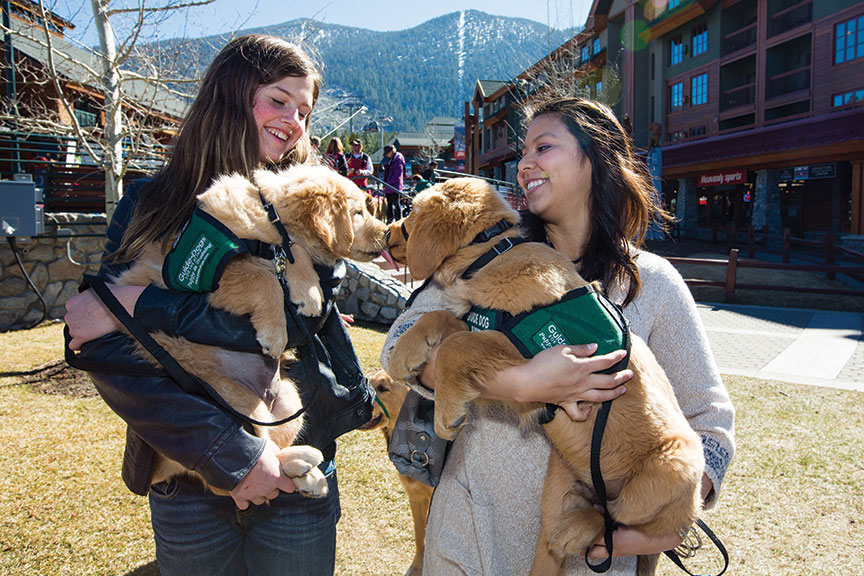
Mikaela Lang and “Linden” socialize with Alicia Silva and “Shadow” at Heavenly Village
Letting Go of the Leash
Dogs graduate sometime between 20 to 24 months. There’s a graduation ceremony, and often the raisers and the blind people their dogs have been matched with stay in touch. “You become a part of their family,” says Wish. “It’s like sending your kids off to college. You know that they were born to do a very special job, so you send them off with the confidence that you’ve done your very best… we still get choked up. It’s still hard to say goodbye.”
He adds, “That’s part of it. You have to become emotionally involved with these dogs. You can’t bring out the best in the dog without being emotionally invested in the process.”
Not all guide dogs are created equal, and they are not one size fits all. They come with all different temperaments and levels of energy, says Wish, which is great because people do, too. “Guide Dogs does a magnificent job matching the needs of the blind person with the abilities and temperament of the dog,” he says.
Guide Dogs’ in-depth matching process takes into account a number of factors, including walking pace, temperament, energy level and size. “When you’re meeting that blind person for the first time, you wonder what they’re going to be like, but you realize when you meet them that you already know because they are so well-matched to the dog that you’ve had for a year,” says Mammen. “It’s like meeting their soulmate. They’re perfect for each other in a lot of ways and you can see that from the very beginning.”
Stern agrees. “They do better than match.com as far as finding a good match for you,” she says.
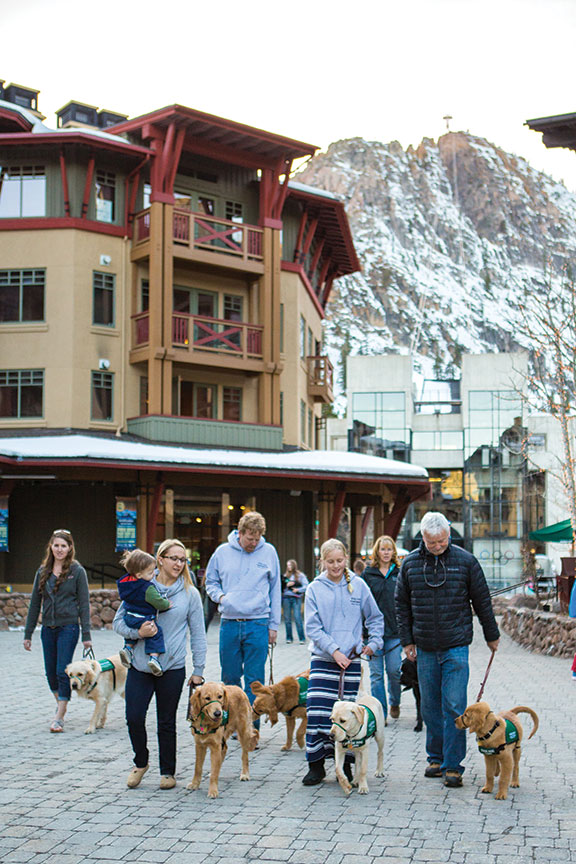
Members of the Carson City and Reno Guide Dog Clubs walk their pups
during an outing this spring in the Village at Squaw Valley
“We raised a high-energy lab one time for a college student who needed a dog that could just keep up with him and be his guide,” says Wish. “One time, we raised a guide dog that was the slowest moving, low-energy dog. This dog was just so slow. Claudia and I said to each other, ‘oh my gosh, how could this become a guide dog?’ And Guide Dogs matched her with a woman who had cerebral palsy along with her blindness, and needed a slow-moving dog not only to guide her, but to put her weight on and help her balance. She lived in downtown Portland, and traveled all around the city on public transportation.”
Cook recalls the last graduation ceremony she attended. “One of the people at the ceremony said, ‘It’s incredible to me that you all are doing this for us. Guide Dogs for the Blind is a huge organization, they have approximately 800 puppies in training at a time, they have 2,000 working guide dogs,’ she said, ‘and you all are doing this for me.’ From the people who volunteer on their campuses to the volunteer puppy raisers to the staff that work there to the mobility instructors, there are so many levels of the organization and everybody is doing it for the same purpose, as a community.”
Only about 60 percent of puppies become Guide Dogs for the Blind. Sometimes they develop a health problem, like allergies or epilepsy, or maybe they drool too much. Sometimes they have too much energy for placement. These dogs can still go on to do extraordinary things, and are referred to as career-changed dogs.
One example is “Subaru,” a career-changed dog from the Carson City club who was disqualified because he drools excessively. The family who raised him adopted him and then realized he had the potential to be a therapy dog at the Carson City District Attorney’s office, assisting with children who have been traumatized by family violence or who have been brought before the court. Now, rather than those children experiencing a terrifying and awful legal process alone, “Subaru” helps them cope, remaining right by their feet for moral support during interviews or trials.
A golden retriever named “Royal” was disqualified because of her high energy, but in her new career as a search and rescue dog at Mt. Rose, she passed her national certifications with flying colors and at a very young age.
Guide dogs don’t always change the lives of those directly working with them, either. Years ago, Wish raised a littermate of a very famous guide dog named “Roselle.”
“Roselle” happened to be in the 72nd floor of the World Trade Center’s Tower 1 on September 11, 2001. She and her blind partner, Michael Hingson, were able to make their way down the stairs as firemen came up. As the building collapsed, they ran as fast as they could on the street. With all the dust and debris, Hingson wasn’t the only one blinded, but because of her familiarity with the area “Roselle” led him and many others to safety.
Changing Lives
While these dogs enhance the lives of their blind partners in more overt ways, the people who raise them are permanently changed by the experience, too. For Wish, it is part of his identity and one of the most important parts of his life. “I would like to feel like I’ve made a difference, that I’ve made a contribution to both my community and in a larger sense to others,” he says. “Relationships with people, relationships with family and these very special dogs, and my career are part of who I am as a person.”
For Cook and Mammen, it solidified their friendship, their love of animals and their desire to help people. At the moment, Mammen is a therapeutic horseback riding instructor at Nevada Equine Assisted Therapy at the UNR equestrian center, and is considering employment as a mobility trainer with Guide Dogs in the future after a successful internship in its training department last summer. Cook is looking to go into the medical field, possibly nursing. They have both adopted career-changed dogs that they raised, and they both intend to continue their involvement with Guide Dogs for as long as they are able.
“The first day that Kelsey and I picked up our puppies, we went down to the San Rafael campus together, and on that day there was a graduation ceremony going on,” says Cook. “I still remember hearing the speeches that day about how people were able to have the freedom to walk to the mailbox by themselves, and that was something they didn’t have before they had their guide dogs. As time progressed I realized that I was doing it not only for the fun of having a puppy, but for the ability to help somebody and the ability to give them a gift that they can never put into words how much it means to them.”
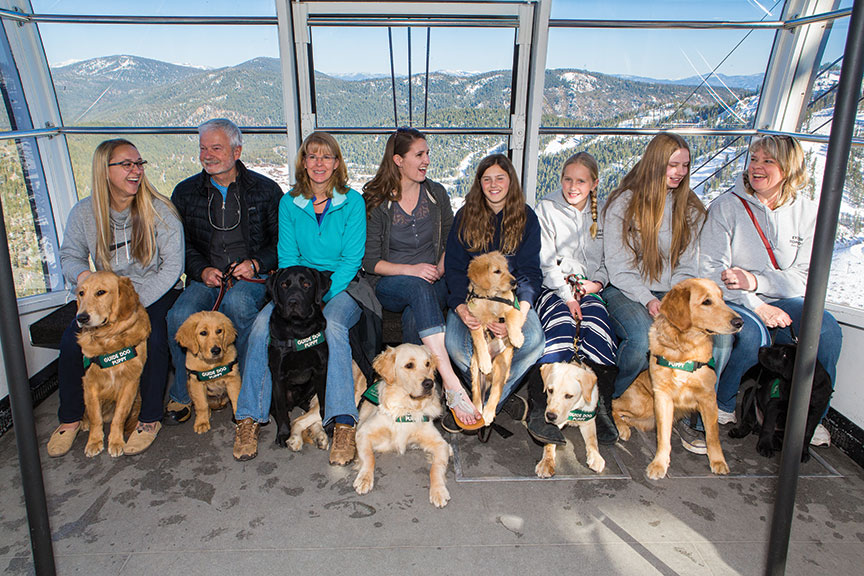
Members of the Carson City and Reno Guide Dog Clubs ride the tram to High Camp at Squaw Valley, just one
more exciting scenario they can expose their pups to during the training process. From left, Danielle Moss and
“Pele,” Denny Sauer and “Scotland,” Terry Hart and “Figby,” Katlynn Shepard and “Theodore,” Mikaela Lang
and ”Linden,” Reaghan Moore and “Roscoe,” Abby Peterson and “Park,” Lynda Peterson and “Gaucho”
Guide Dogs for the Blind works tirelessly to get the word out and let blind people know that it is there as a resource. At no charge, any person with low vision or no vision who is mobile can receive a guide dog, and all veterinary and transportation costs are covered. The nonprofit has a budget of more than $20 million each year ($7 million of which is veterinary costs), all funded from private donations.
Stern’s dogs have changed—and even saved—her life. She has numerous stories where her dogs have blocked her from harm, and can recall the amazing feeling of trust. Despite their superhuman (or super-canine?) discipline, even a pro can still have some uniquely doggy moments. One of Stern’s funnier moments with “Blossom” occurred when she was living in San Francisco. “We were walking down Fillmore Street, and I kept hearing people laughing,” she says. “I reached down to pet “Blossom” to praise her for finding the curb and I realized she had this big apple sticking out of her mouth. She was doing perfect guide work, just somewhere she had picked up this giant apple and she was just walking around with it.” She laughs. “At the end of the day, dogs are dogs.”
And these dogs are amazing.
Jen Schmidt is an Incline Village–based photographer and proud owner of a golden retriever. Find more of her work at www.jenschmidtphotography.com.




No Comments